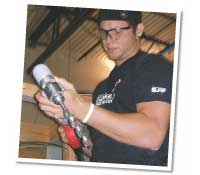The Cisco 350-701 Exam Questions, also known as Implementing and Operating Cisco Security Core Technologies (SCOR), evaluates a candidate's understanding and proficiency in implementing core security technologies and strategies using Cisco devices. This exam covers various topics such as network security, cloud security, content security, endpoint protection, secure network access, visibility, and enforcement. Candidates are assessed on their ability to implement security solutions, secure network access, implement threat defense, and manage security policies and procedures effectively within a Cisco environment. Passing the 350-701 exam demonstrates expertise in securing Cisco networks and infrastructure against modern cybersecurity threats.
CEDIA Installer Boot Camp: Making the Grade Page 5
 By the time we shuttled back to our hotel, I was exhausted from the sheer volume of information I'd absorbed. But I still needed dinner, so I walked to the one nearby restaurant said to have edible food. Of course, everyone in our class had heard the same rumor. Soon, about ten of us - including Grayson and Greg - were getting to know each other over beers and burgers. Building friends within the industry is a big part of what Boot Camp - and CEDIA - is about.
By the time we shuttled back to our hotel, I was exhausted from the sheer volume of information I'd absorbed. But I still needed dinner, so I walked to the one nearby restaurant said to have edible food. Of course, everyone in our class had heard the same rumor. Soon, about ten of us - including Grayson and Greg - were getting to know each other over beers and burgers. Building friends within the industry is a big part of what Boot Camp - and CEDIA - is about.
The next couple of days followed this "learn it, use it" cycle - in by 8 a.m., then back and forth from classroom to lab all day. We proceeded logically through the remaining phases of an install: prewire (pulling cables), trim-out (terminating and dressing the cables in preparation for sheetrock), initial cable testing (where we played with awesome electronic testers that can detect shorts, breaks, and even mis-wired Cat-5 connectors), and final equipment installation and testing.
Along the way we did our retrofit exercise, and I finally got to see how to run wires through a wall that's already up. Our instructors warned us that retrofit is as much an art form as a craft, and they were right: It turned out to be the hardest part of the install. We just had to mount a pair of speakers and a volume control, and we had all kinds of special tools to do it: fiberglass fish rods, a magnetic wand designed to grab a metal ring and ball-chain, and my favorite, the walleye - a combination periscope/flashlight that lets you peek into dark cavities to find drilled holes or obstructions. But you're essentially working blind and by feel, and it takes a very light touch and a great deal of patience and practice to get the job done.
At the end of the course, we were given a 20-question take-home test to reinforce the key material. But seven students paid to stay another half-day and take the full Level I certification exam, which earns you a strong credential valued by install shops across the land. It's serious stuff - you get 3 hours to answer 100 multiple-choice questions that cover everything we learned in Boot Camp, plus a few things that would be common knowledge for installers with a bit of experience.
 So, instead of hanging late at the bar with my fellow campers after our last class, I went back to my hotel room and stayed up most of the night to cram. I reviewed every page of the giant course guide, studied all my notes, practiced my Ohm's Law calculations - all so I wouldn't have to write in a national magazine that I'd flunked. [Whew!-Ed.]
So, instead of hanging late at the bar with my fellow campers after our last class, I went back to my hotel room and stayed up most of the night to cram. I reviewed every page of the giant course guide, studied all my notes, practiced my Ohm's Law calculations - all so I wouldn't have to write in a national magazine that I'd flunked. [Whew!-Ed.]
By the time I stumbled into the exam room the next morning, I looked like hell. The test was challenging; as hard as I'd studied, I still had to take educated guesses on about 20 questions and outright eeny-meeny-miney-moes for a handful more - this on an exam with a passing grade of 70. Indeed, two out of the seven in my test group failed to make the cut. But my Boot Camp experience obviously succeeded in drilling something into my thick skull: When I got the results a short while later, I'd scored 90 out of 100!
- Log in or register to post comments






























































